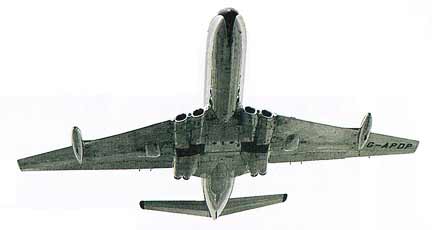Dehavilland Comet

The DeHavilland DH.106 Comet was the world's first commercial jet airliner to be produced. Developed and manufactured by DeHavilland, the Comet first flew in 1949 and was a revolutionary in aeronautical design. The DeHavilland Comet had an extremely aerodynamically clean design with its four DeHavilland Ghost turbojet engines placed into the wings, a light-noise pressurized cabin, and huge windows; for its time, the Comet was an extremely comfortable aircraft for passengers and showed promise of being a major success shortly after launching.
However, a few years after being introduced into commercial service, DH.106 Comet airframes began suffering from major metal fatigue, causing two accidents where the aircraft was torn apart in mid-flight. The DeHavilland Comet had to be withdrawn and tested to find the cause. The first accident was mistakenly identified as having been caused by a fire onboard the aircraft. Several contributory factors, such as window installation methodology, were also identified as exacerbating the problem. The Comet was extensively redesigned to eliminate this design flaw. Other aircraft manufacturers manufactured new designs based on what they had learned from DeHavilland's groundbreaking DH.106 Comet.

 Fitting four engines in the wing roots reduced drag and gave the Comet an outstandingly beautiful profile. |
 The first production Comet made its first maiden flight on January 9, 1951. |
 After its initial problems were worked out, the DeHavilland Comet serviced customers for 30 years. |
 Britain and Canada were the only users of military transport Comets, using them until 2011. |
 DeHavilland's DH.106 Comet was the world's first jet airliner, and it had no rival. |
|
 |
|||
| A: The comet was one of the first pressurized commercial aircraft, and once the catastrophic metal fatigue problem was solved it offered passengers a very comfortable flight. | B: The comet 4 series was nearly 26 ft. longer than the Comet 1. Originally designed to house 101 passengers, as a charter airliner in its later life it had a capacity of 119. |
C: The wing was very efficient and gave the comet a lower stall speed than many contemporary propeller-driven aircraft. Most of it was taken up by a huge sealed fuel tank. | D: The fuselage was pressurized to give a 6,500 ft. cabin pressure when flying at 40,000 ft. Four-abreast one- or two-class seating was the norm. |
| E: The Comet originated long before swept-wing data became general knowledge, and the tail was of conventional straight design. | F: The flight deck accommodated two pilots, a flight engineer and a navigator. | G: The Comet's engines were buried in the wing roots. More efficient aerodynamically than 'podded' engines. | H: The external fuel tank mounted on the lower leading edge of the wing was the main identification feature. |



